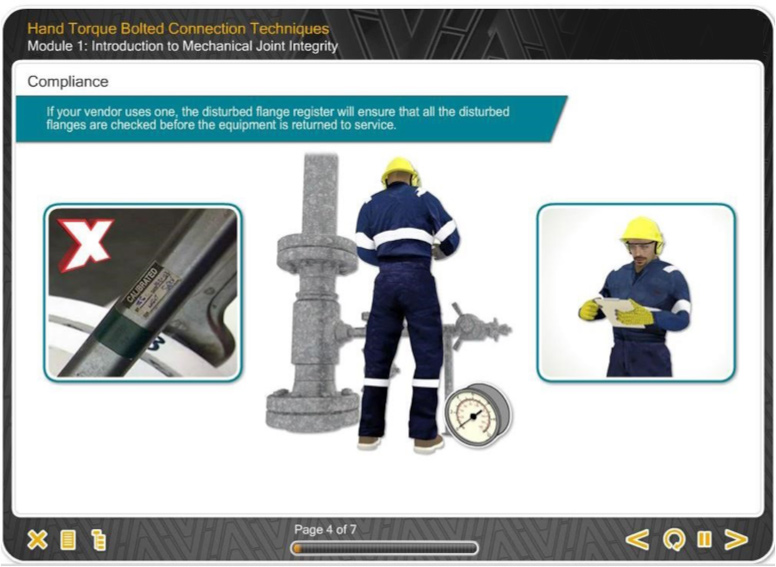ECITB MJI 10 eLearning Module –
Hand Torque Bolted Connection Techniques

Duration: 105mins
Level: Intermediate
Pass mark: 80%
Course Description
Who is the course for?
This eLearning course is aimed at workers requiring refresher training before taking the ECITB technical test for ECITB standard MJI10: Hand Torque Bolted Connection Techniques.
Is previous experience required?
It is expected that as a participant in this course, you will have received formal training in working with mechanical joints and that you hold suitable qualifications. Completion of this course does not certify you to the ECITB standard but it will prepare you for the technical test.
How will the course benefit me?
Incorrectly bolted flanges are one of the main causes of hydrocarbon releases, which can have a serious impact on the environment, operating costs and the safety of personnel. This course will give you an understanding of how mechanical joints work and how to use hand torque tightening.
The knowledge gained in this course will help you understand how to dismantle, remove and replace components correctly to minimise the leaks and safety concerns associated with incorrectly bolted flanges. It will give an overview of hand torque equipment and how it should be used.
How will the course benefit my company?
By properly making up bolted joints, you contribute to the integrity of the asset, and the safety of your fellow workers and yourself. A reduction in hydrocarbon releases means a reduced environmental impact and reduced losses of revenue.
What standards are referenced in the course?
This course is written with reference to the ECITB standard MJI10: Hand Torque Bolted Connection Techniques. The course has been approved by ECITB as part of the ECITB/Step Change in Safety MJI model.
Is there an assessment?
Once you have completed the course, you will be asked a series of questions to check your knowledge and understanding. These are based on the learning objectives for the course and have a pass mark of 80%.
Learning Objectives
- This unit specifies the skilled performance expected of persons trained to dismantle, inspect, prepare, assemble and tighten flanged and clamp connector pipe joints using hand torque equipment.
- Describe the specifications covering dismantling, preparation and securing of bolted connections
- Explain how compliance is checked
- Introduce the bolted mechanical joint
- Explain the different kinds of flanges available
- Provide an overview of nuts and bolt technology
- Show the different gasket types
- Describe the correct installation of gaskets
- Describe uncontrolled tightening
- Describe partially controlled tightening
- Describe fully controlled tightening
- Describe the various measuring tools available for controlled tightening
- Show the effects of too low stresses being used
- Show the effects of too high stresses being used
- Explain how torque is calculated
- Explain that the amount of torque put in is not always transferred to the bolt
- Describe how to reduce friction
- Recognise level and extent of responsibility when dismantling bolted connections
- Specify the type of assets to be dismantled and the methods
- Identify isolations and disconnections that may be required
- Describe methods and techniques required for dismantling
- Identify typical problems and how to resolve them
- Recognise level and extent of responsibility when replacing bolted connections
- Describe the types of equipment that might be worked on
- Describe a range of components that may be replaced
- Confirm that replacement parts are suitable
- Describe methods and techniques required for re-assembly
- Identify typical problems and how to resolve them
- Describe the components of typical hand torque equipment
- Explain the operation of typical hand torque equipment
- Give an example of hand torque tightening
Available ECITB eLearning Modules:
Further Information
Enquire about eLearning Courses

